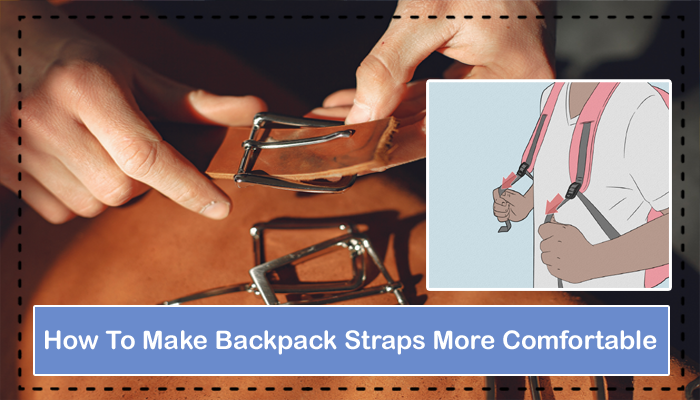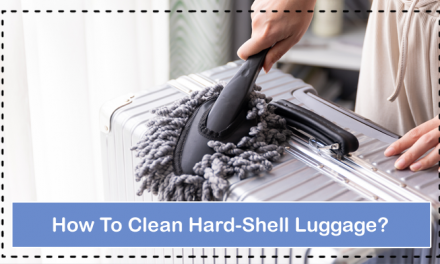Whenever you are going hiking or traveling, the first thing you need is a backpack for carrying your important stuff. As soon as you carry it to begin your journey, you realize that either the straps are not fit snugly to the shoulders or the straps are too tight to cause discomfort. Sometimes you may feel that the straps are chafing your skin.
At the start, you may ignore this issue. But as you travel some distance with the imperfectly fitted backpack straps, this discomfort grows into immense pain in the neck and shoulders and you will feel that you are carrying the weight of the earth on your back and shoulders. This discomfort and pain will not subside unless you correctly adjust your straps to avoid any pressure on the neck and shoulder.
Some people don’t bother to give attention to this problem and call it a trivial issue but gradually they realize they were wrong. The unattended discomfort and pain eventually affect the quality of life. One might develop constant pain in the neck, shoulders, and lower back, and worst of all, they develop a bad slouching posture which is visually unappealing.
Structure Of The Backpack
Before we dive into learning how to make backpack straps more comfortable, we should know the anatomy of the backpack. So, when doing steps to make straps comfortable, it will be easier for us to make out why we are doing it.
The backpack comprises of the following:
- Bag
- Shoulder harness
- Hip belt
- Load lifters
The Bag that you’re placing everything into can assume a critical part in comfort also. Many bags have horizontal pressure straps that help straighten out the heap of the load so it’s not floundering around everywhere. It is easier to carry the backpack when the load is tighter and the weight is evenly distributed.
By and large, you don’t need the shoulder straps to be tight to the point that they’re awkward and you don’t need all the heaviness of the pack overwhelming them. If the frame of the backpack is designed to support load, you ought to have the option to slacken your shoulder straps as much as possible and have the pack stay set up on your hips.
If this isn’t going on for you, investigate what’s happening and fix it.
Shoulder harnesses/straps are there to give support to the load, not endure its worst part. Gradually fix them down until they’re cozy. Then, make sure the sternum strap is directly about at your nipples, clasp it, and gradually fix it. You may like to experiment where it feels best by adjusting it up and down, yet one thing to make certain of isn’t to wrench that thing down or you will feel clustered up.
The hip belt is appended to the lower part of the frame which bears virtually all that pack weight. If the hip belt is properly fitted and of high quality, then the weight of the pack is moved into the frame of your body, which is unbending.
If the hip belt is excessively low, you may feel some is pulling you down. If it’s excessively high, you may not take full advantage of your skeleton assuming the weight of the pack. You must have the correct measurement for the appropriate fit of the hip belt. You need the belt to be cozy, not free, and fold over your hips appropriately or, in all likelihood, it will not work.
The load lifters seem as though a piece of strap going from your shoulder straps to the highest point of your pack. These ought to be let completely free, then gradually tightened until you feel the load rises a little bit. They can be the real cause of imperfect fitting. If excessively tight, you’ll feel clustered up, if excessively free, you’ll feel like being dragged downward.
A speedy and simple approach to fix an awkwardly fitted backpack is to check the entirety of the above components of your backpack to ensure the comfortable wearing of the pack.
Factors Which Can Affect Backpack Strap Comfortability
Apart from the improper fitting of straps, several other factors can account for the pain and uncomfortability caused by the backpack.
- Weight Distribution Inside Backpack
Usually, the pain and uncomfortability aren’t brought about by the backpack, yet how they are pressed. The backpack’s legitimate weight dissemination can tackle the vast majority of the issues identified with pain brought about by a load. It can save you a high measure of imperative energy keeping your backpack stable.
So, saving energy is vital, particularly when you are climbing up a hill.
The weightiest objects put in the backpack ought to be arranged close to the spine. On the off chance that the heap in a pack isn’t balanced, i.e., one side of the sack has substantially more burden than the others; at that point, the body muscles of that side need to work more diligently than others. This makes back and bears distress, just as an antagonistic effect on your strolling efficiency.
To deal with the pain caused by the backpack strap, hold the heaviest things focused and clinched however much as could be expected, ideally high against your spine. Place medium-sized articles around the side of the heaviest ones. External pockets ought to be utilized to hold lighter things, yet recall that load on each side of your pack ought to be even.
Pressing your stuff inside a backpack strap in this streamlined way uses your body’s strength and expands the work process.
- Size of the Bag
The most widely recognized issue while utilizing a rucksack is that it has a more torso than the pack. This accounts for lower back pain hence, your stuff ought to be as indicated by your middle length. Torso’s Length is the distance between the C7 vertebrae and the iliac peak.
C7 vertebrae are situated where your shoulder and back muscles meet, and it is clear to discover at your neck. To find your C7 vertebra, stand upright and slide your hand over the rear of your neck to the spine; the principal bump to feel is the C7 vertebrae. This point is practically on a level with your shoulder bones.
You can likewise consider an appropriate marker that your backpack ought not ascent excessively higher than this point.
Tracking down your iliac crest is very easy, as it is the top of your hip bone. Fundamentally, you place your hands over your hips’ top, and where your forefingers meet behind you is the place where the lower part of your backpack ought to rest.
- Inappropriate backpack fit
People use different approaches to carrying a backpack and some of them are inappropriate enough to cause back shoulder, and neck pain. Always, attempt to keep away from these positions!
- One Strap Sling Backpack Method
It just looks cool and modern to place your backpack buckled over a single shoulder, utilizing just one strap. This position directly puts all stress on one side of the shoulders. You can’t stroll with a great stance with a heap of load on one shoulder alone.
Specialists indicate this one-shoulder backpack wearing can prompt a helpless stance and undeniable irritation in the back, shoulders, and neck. Even if you’re switching to and fro between shoulders to put weight on both shoulders alternately, you are strolling cockeyed.
This puts a lopsided strain on the entire bones and muscles of the chest area, hips, and core.
Set aside the effort to utilize both straps and try to position the backpack a bit high on the back so it won’t influence the progression.
- Position on the Back
When your backpack is low on the back, it puts excessive stress on your shoulders. It may put strains on the shoulder and lower back. Maybe this is what you are doing since you are extricating the strap to make the process of wearing and taking off a backpack simpler.
The low back position encourages a forward bending gait, which spots tension on the lower back. The loose straps will additionally permit the pack to move to and fro when you walk; this can be pretty awkward and may bring about the straps scraping your shoulders.
If you experience issues changing the strap, maybe they are broken or cannot be bound accurately. You might discover guidance on the company’s website on the best way to change them and guarantee they are appropriately stringing through the system. If that doesn’t work out for you, it’s presumably advantageous to get another backpack that features effectively flexible lashes.
Adequate Backpack Fit
Utilize these instructions to get the correct backpack position each time you put on your knapsack. You may have to rehearse these carefully for some time to make them a propensity.
Continuously wear both shoulder ties instead of throwing your backpack with one lash on one side of the shoulder. It pauses for a minute longer however this straightforward propensity can help forestall pain afterward.
If the backpack provides a waist strap or chest strap, this provides more stability. waist straps help to evenly distribute pressure on the hip, alleviating shoulder pressure. A chest strap helps keep the shoulder straps set up and diminishes any swinging of the backpack.
Properly adjust the shoulder straps so the backpack is high on your back and the shoulder straps are snugly fit over your shoulders. The pack ought not to stretch out past your abdomen, it should always be some inches higher above the hips.
Straighten out the straps when you are wearing various thicknesses of garments so they are not very close nor excessively free.
Your backpack should not move from one side to another as you walk. That can prompt irritation from shoulder straps. Continuous rubbing on the back also causes discomfort. A steady burden is better.
With your pack fitted and situated appropriately, you ought to have the option to wear it in any event, for running without it causing you pain and discomfort.
Tips To Achieve Proper Backpack Fit
For achieving proper backpack fit, the following steps are the basic and first things to do.
Measure Torso
You just need a little help from your friend at this step. Toss the measuring tape to your friend. Bend your head forward. Ask your friend to place the end of the measuring tape on the bump of your neck, which is the C7 vertebrae. Place your hands on your hip with the thumb reaching behind, this is the point of your iliac crest. Measure up to the iliac crest. This will give you the torso’s length.
You can use this torso’s length to find the bag size.
Measure Hip Size
The hip measurement is also significant as the hips can take most of the load of the backpack. So, the properly fitted hip strap is considerably important. Again use a measuring tape for this step.
Adjust Torso Length On Backpack Strap
While purchasing a backpack, you must emphasize that it must fit your torso. Reverify and reset torso length if your different changes don’t fit appropriately. Adjustment straps can be set appropriately according to your torso
Conclusion
The pain or discomfort on the neck, shoulder, and lower back should never be ignored as it can develop into serious deformity and bad posture. Always make sure you are not carrying unnecessary items in your backpack. Keep it as light as possible. Furthermore, before buying the backpack, always go for the high quality that offers good adjustability.
The fun of hiking and traveling should never be compromised with the uncomfortable backpack. So, you should never take it as a trivial issue. Why not make it more comfortable when it is possible with just simple tips.
Hoping that this article has helped you, we are signing off.
Read also: How To Tamper Proof Zipper Luggage – Quick Hacks 2021
Read also: How to get a Backpack Zipper Unstuck?
Read also: Best crossbody travel bag with water bottle holder
Read also: Best Rolling Briefcase for Lawyers
Read also: How to Wear a Backpack Properly-Right Way
Read also: Tips on How to Clean Your Backpacks
Read also: How to Wear a Backpack Properly-Right Way






